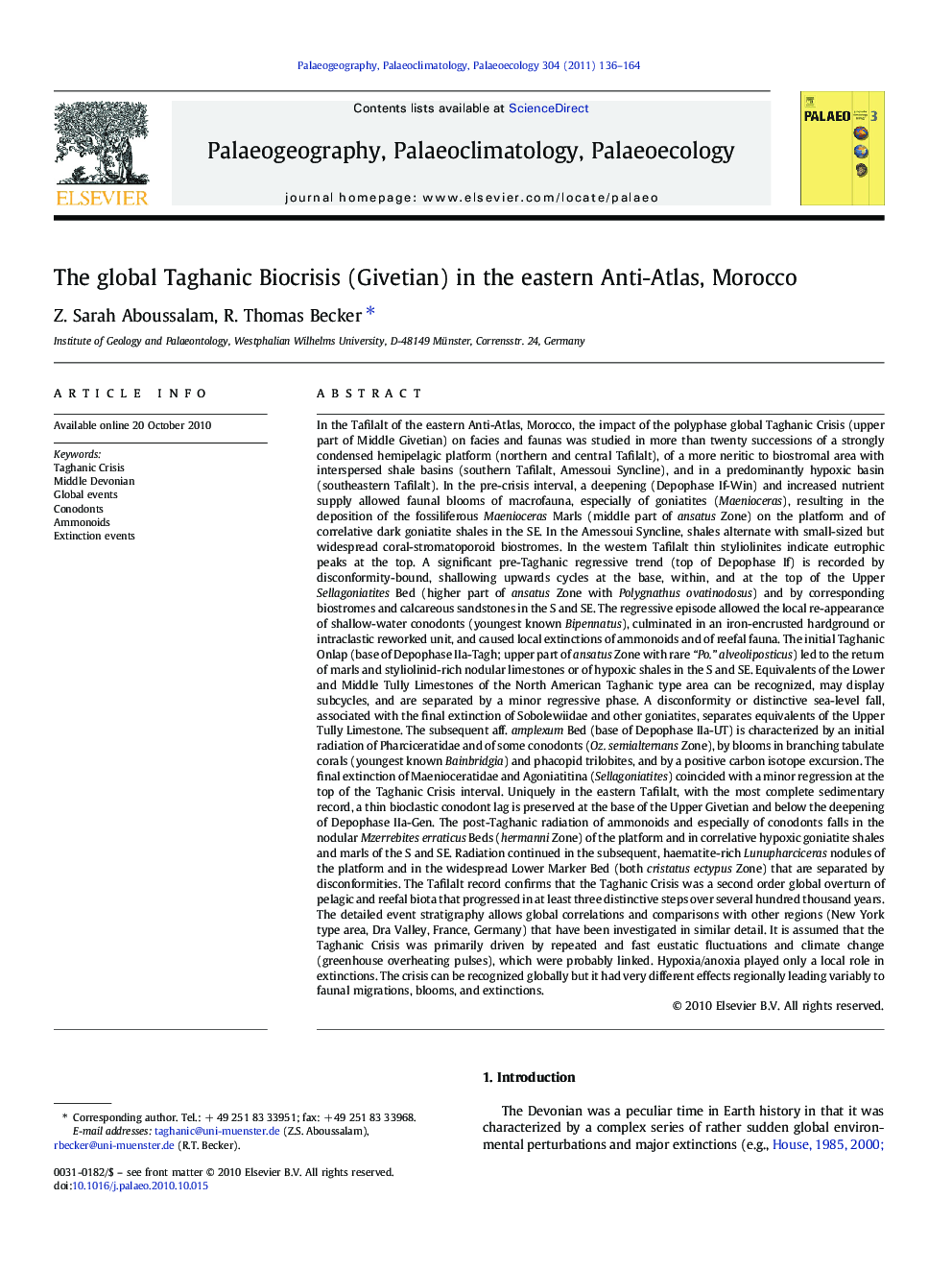| کد مقاله | کد نشریه | سال انتشار | مقاله انگلیسی | نسخه تمام متن |
|---|---|---|---|---|
| 4467391 | 1622258 | 2011 | 29 صفحه PDF | دانلود رایگان |

In the Tafilalt of the eastern Anti-Atlas, Morocco, the impact of the polyphase global Taghanic Crisis (upper part of Middle Givetian) on facies and faunas was studied in more than twenty successions of a strongly condensed hemipelagic platform (northern and central Tafilalt), of a more neritic to biostromal area with interspersed shale basins (southern Tafilalt, Amessoui Syncline), and in a predominantly hypoxic basin (southeastern Tafilalt). In the pre-crisis interval, a deepening (Depophase If-Win) and increased nutrient supply allowed faunal blooms of macrofauna, especially of goniatites (Maenioceras), resulting in the deposition of the fossiliferous Maenioceras Marls (middle part of ansatus Zone) on the platform and of correlative dark goniatite shales in the SE. In the Amessoui Syncline, shales alternate with small-sized but widespread coral-stromatoporoid biostromes. In the western Tafilalt thin styliolinites indicate eutrophic peaks at the top. A significant pre-Taghanic regressive trend (top of Depophase If) is recorded by disconformity-bound, shallowing upwards cycles at the base, within, and at the top of the Upper Sellagoniatites Bed (higher part of ansatus Zone with Polygnathus ovatinodosus) and by corresponding biostromes and calcareous sandstones in the S and SE. The regressive episode allowed the local re-appearance of shallow-water conodonts (youngest known Bipennatus), culminated in an iron-encrusted hardground or intraclastic reworked unit, and caused local extinctions of ammonoids and of reefal fauna. The initial Taghanic Onlap (base of Depophase IIa-Tagh; upper part of ansatus Zone with rare “Po.” alveoliposticus) led to the return of marls and styliolinid-rich nodular limestones or of hypoxic shales in the S and SE. Equivalents of the Lower and Middle Tully Limestones of the North American Taghanic type area can be recognized, may display subcycles, and are separated by a minor regressive phase. A disconformity or distinctive sea-level fall, associated with the final extinction of Sobolewiidae and other goniatites, separates equivalents of the Upper Tully Limestone. The subsequent aff. amplexum Bed (base of Depophase IIa-UT) is characterized by an initial radiation of Pharciceratidae and of some conodonts (Oz. semialternans Zone), by blooms in branching tabulate corals (youngest known Bainbridgia) and phacopid trilobites, and by a positive carbon isotope excursion. The final extinction of Maenioceratidae and Agoniatitina (Sellagoniatites) coincided with a minor regression at the top of the Taghanic Crisis interval. Uniquely in the eastern Tafilalt, with the most complete sedimentary record, a thin bioclastic conodont lag is preserved at the base of the Upper Givetian and below the deepening of Depophase IIa-Gen. The post-Taghanic radiation of ammonoids and especially of conodonts falls in the nodular Mzerrebites erraticus Beds (hermanni Zone) of the platform and in correlative hypoxic goniatite shales and marls of the S and SE. Radiation continued in the subsequent, haematite-rich Lunupharciceras nodules of the platform and in the widespread Lower Marker Bed (both cristatus ectypus Zone) that are separated by disconformities. The Tafilalt record confirms that the Taghanic Crisis was a second order global overturn of pelagic and reefal biota that progressed in at least three distinctive steps over several hundred thousand years. The detailed event stratigraphy allows global correlations and comparisons with other regions (New York type area, Dra Valley, France, Germany) that have been investigated in similar detail. It is assumed that the Taghanic Crisis was primarily driven by repeated and fast eustatic fluctuations and climate change (greenhouse overheating pulses), which were probably linked. Hypoxia/anoxia played only a local role in extinctions. The crisis can be recognized globally but it had very different effects regionally leading variably to faunal migrations, blooms, and extinctions.
Journal: Palaeogeography, Palaeoclimatology, Palaeoecology - Volume 304, Issues 1–2, 15 April 2011, Pages 136–164